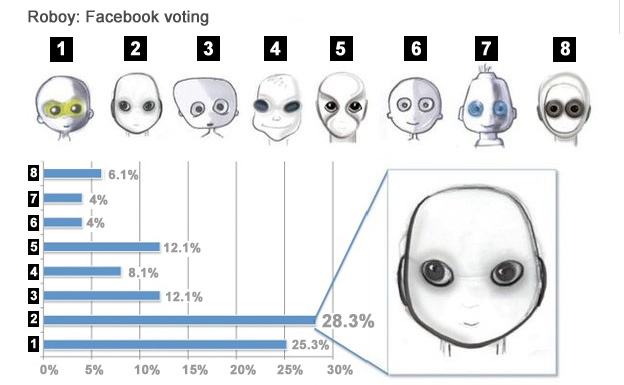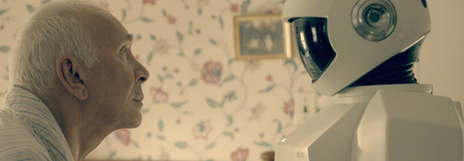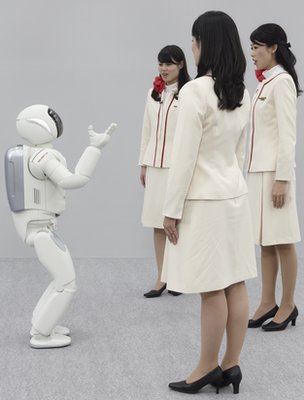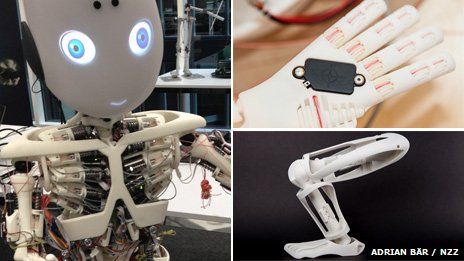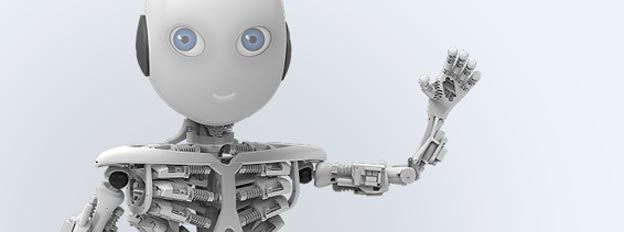
A new robot unveiled this
week highlights the psychological and technical challenges of designing
a humanoid that people actually want to have around.
Like all little boys, Roboy likes to show off.
He can say a few words. He can shake hands and wave. He is
learning to ride a tricycle. And - every parent's pride and joy - he has
a functioning musculoskeletal anatomy.
But when Roboy is unveiled this Saturday at the Robots on
Tour event in Zurich, he will be hoping to charm the crowd as well as
wow them with his skills.
"One of the goals is for Roboy to be a messenger of a new
generation of robots that will interact with humans in a friendly way,"
says Rolf Pfeifer from the University of Zurich - Roboy's
parent-in-chief.
As manufacturers get ready to market robots for the home it has become essential for them to overcome the public's suspicion of them. But designing a robot that is fun to be with - as well as useful and safe - is quite difficult.
-----
The uncanny valley: three theories
Researchers have speculated about why we might feel uneasy in the presence of realistic robots.
- They remind us of corpses or zombies
- They look unwell
- They do not look and behave as expected
-----
Roboy's main technical innovation
is a tendon-driven design that mimics the human muscular system.
Instead of whirring motors in the joints like most robots, he has around
70 imitation muscles, each containing motors that wind interconnecting
tendons. Consequently, his movements will be much smoother and less
robotic.
But although the technical team was inspired by human beings,
it chose not to create a robot that actually looked like one. Instead
of a skin-like covering, Roboy has a shiny white casing that proudly
reveals his electronic innards.
Behind this design is a long-standing hypothesis about how people feel in the presence of robots.
In 1970, the Japanese roboticist Masahiro Mori speculated that
the more lifelike robots become, the more human beings feel familiarity
and empathy with them - but that a robot too similar to a human
provokes feelings of revulsion.
Mori called this sudden dip in human beings' comfort levels the "uncanny valley".
"There are quite a number of studies that suggest that as
long as people can clearly see that the robot is a machine, even if they
project their feelings into it, then they feel comfortable," says
Pfeifer.
Roboy was styled as a boy - albeit quite a brawny one - to
lower his perceived threat levels to humans. His winsome smile - on a
face picked by Facebook users from a selection - hasn't hurt the team in
their search for corporate sponsorship, either.
But the image problem of robots is not just about the way they look. An EU-wide survey last year found that although most Europeans have a positive view of robots, they feel they should know their place.
Eighty-eight per cent of respondents agreed with the
statement that robots are "necessary as they can do jobs that are too
hard or dangerous for people", such as space exploration, warfare and
manufacturing. But 60% thought that robots had no place in the care of
children, elderly people and those with disabilities.
The computer scientist and psychologist Noel Sharkey has,
however, found 14 companies in Japan and South Korea that are in the
process of developing childcare robots.
South Korea has already tried out robot prison guards, and three years ago launched a plan to deploy more than 8,000 English-language teachers in kindergartens.
-----
A robot buddy?
- In the film Robot and Frank, set in the near-future, ageing
burglar Frank is provided with a robot companion to be a helper and
nurse when he develops dementia
- The story plays out rather like a futuristic buddy movie -
although he is initially hostile to the robot, Frank is soon programming
him to help him in his schemes, which are not entirely legal
-----
Cute, toy-like robots are already available for the home.
Take the Hello Kitty robot, which has been on the market for
several years and is still available for around $3,000 (£2,000).
Although it can't walk, it can move its head and arms. It also has
facial recognition software that allows it to call children by name and
engage them in rudimentary conversation.
A tongue-in-cheek customer review of the catbot on Amazon reveals a certain amount of scepticism.
"Hello Kitty Robo me was babysit," reads the review.
"Love me hello kitty robo, thank robo for make me talk
good... Use lots battery though, also only for rich baby, not for no
money people."
-----
Asimo
At just 130cm high, Honda's Asimo jogs around on bended knee
like a mechanical version of Dobby, the house elf from Harry Potter. He
can run, climb up and down stairs and pour a bottle of liquid in a cup.
Since 1986, Honda have been working on humanoids with the ultimate aim of providing an aid to those with mobility impairments.
-----
The product description says the
robot is "a perfect companion for times when your child needs a little
extra comfort and friendship" and "will keep your child happily
occupied". In other words, it's something to turn on to divert your
infant for a few moments, but it is not intended as a replacement
child-minder.
An ethical survey
of "robot nannies" by Noel and Amanda Sharkey suggests that as robots
become more sophisticated parents may be increasingly tempted to hand
them too much responsibility.
The survey also raises the question of what long-term effects
will result from children forming an emotional bond with a lump of
plastic. They cite one case study in which a 10-year-old girl, who had
been given a robot doll for several weeks, reported that "now that she's
played with me a lot more, she really knows me".
Noel Sharkey says that he loves the idea of children playing
with robots but has serious concerns about them being brought up by
them. "[Imagine] the kind of attachment disorders they would develop,"
he says.
But despite their limitations, humanoid robots might yet
prove invaluable in narrow, fixed roles in hospitals, schools and homes.
"Something really interesting happens between some kids with
autism and robots that doesn't happen between those children and other
humans," says Maja J Mataric, a roboticist at the University of Southern
California. She's found that such children respond positively to
humanoids and she is trying to work out how they can be used
therapeutically.
In their study, the Sharkeys make the observation that robots have one
advantage over adult humans. They can have physical contact with
children - something now frowned upon or forbidden in schools.
"These restrictions would not apply to a
robot," they write, "because it could not be accused of having sexual
intent and so there are no particular ethical concerns. The only concern
would be the child's safety - for example, not being crushed by a
hugging robot."
When it comes to robots, there is such a thing as too much love.
"If you were having a mechanical assistant in the home that
was powerful enough to be useful, it would necessarily be powerful
enough to be dangerous," says Peter Robinson of Cambridge University.
"Therefore it'd better have really good understanding and
communication."
His team are developing robots with sophisticated facial
recognition. These machines won't just be able to tell Bill from Brenda
but they will be able to infer from his expression whether Bill is
feeling confused, tired, playful or in physical agony.
Roboy's muscles and tendons may actually make him a safer
robot to have around. His limbs have more elasticity than a conventional
robot's, allowing for movement even when he has a power failure.
Rolf Pfeifer has a favourite question which he puts to those sceptical about using robots in caring situations.
"If you couldn't walk upstairs any more, would you want a person to carry you or would you want to take the elevator?"
Most people opt for the elevator, which is - if you think about it - a kind of robot.
Pfeifer believes robots will enter our homes. What is not yet
clear is whether the future lies in humanoid servants with a wide range
of limited skills or in intelligent, responsive appliances designed to
do specific tasks, he says.
"I think the market will ultimately determine what kind of robot we're going to have."
You can listen to Click on the BBC World Service. Listen back to the robots for humans special via iplayer or browse the Click podcast archive.


